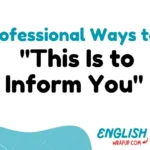In the colorful tapestry of language, idioms stand as vibrant threads, weaving together culture, history, and expression. Idioms are phrases that carry a figurative meaning beyond the literal interpretation of their individual words.
They add richness and depth to communication, often conveying ideas and concepts more vividly than plain language ever could. Mastering idioms is a key aspect of language fluency, as they allow speakers to convey nuances, emotions, and cultural insights with finesse.
Is it Professional to Say “To Answer Your Question”
Yes, “To answer your question” is a professional and courteous way to transition into directly addressing a query that has been posed. It acknowledges the importance of the question and signals to the listener or reader that you are about to provide a response.
This phrase is commonly used in various professional settings, including meetings, interviews, presentations, and written communications, to ensure clarity and effective communication.
List of Professional Ways to Say “To Answer Your Question”
- Regarding your question…
- In response to your query…
- To address what you asked…
- In relation to your inquiry…
- To clarify your question…
- With regard to what you asked…
- To speak directly to your question…
- To respond to your inquiry…
- To provide an answer to your question…
- With respect to your question…
- To tackle your question…
- To shed light on your inquiry…
- To offer a response to your question…
- In consideration of your question…
- To delve into your query…
- To provide clarity on your question…
- To give you an answer…
- With reference to your question…
- To address your concern…
- In regard to your question…
- To offer some insight into your query…
- To provide some information on your question…
- In connection with your inquiry…
- To give you some context on your question…
- To respond to what you asked…
- To give you my thoughts on your question…
- To offer some perspective on your inquiry…
- To give you a response…
- To provide you with some feedback on your question…
- To give you a reply…
- To provide some input on your query…
- To share my thoughts on your question…
- In light of your question…
- To offer you some information on your inquiry…
- To offer some guidance regarding your question…
Regarding your question…
This phrase signals an intention to address the specific question or inquiry posed by the interlocutor. It is commonly understood as a polite and formal way to acknowledge and respond to a query.
Example: “Regarding your question about the project deadline, we anticipate completing it by the end of the month.”
In response to your query…
“In response to your query” indicates a direct and explicit reply to the question posed. It’s commonly used in formal settings, such as professional emails or academic discourse.
Example: “In response to your query about the new policy, I can provide you with further details during our meeting tomorrow.”

To address what you asked…
This expression signifies an intention to tackle or deal with the specific question or concern raised by the other party. It’s suitable for both formal and informal contexts.
Example: “To address what you asked regarding the budget allocation, we’ve reallocated resources to prioritize key initiatives.”
In relation to your inquiry…
By stating “In relation to your inquiry,” the speaker acknowledges the relevance of the question and offers a response or explanation. It’s suitable for formal contexts where precision and clarity are important.
Example: “In relation to your inquiry about the market trends, our latest report provides comprehensive insights into consumer behavior.”
To clarify your question…
This expression indicates an intention to provide clarity or further explanation in response to a question that may be ambiguous or unclear. It’s suitable for both formal and informal settings.
Example: “To clarify your question about the project scope, let me outline the specific deliverables we aim to achieve.”
With regard to what you asked…
“With regard to what you asked” acknowledges the relevance of the question and signals an intention to provide a response or address the issue raised. It’s suitable for formal and polite communication.
Example: “With regard to what you asked about the logistics plan, we’re currently finalizing the details and will provide an update shortly.”
To speak directly to your question…
This expression emphasizes a direct and focused response to the question posed, without veering off topic. It’s suitable for both formal and informal settings.
Example: “To speak directly to your question about our marketing strategy, our approach is centered around targeted digital campaigns.”
Other Ways to Say “I Look Forward to Learning From You”
To respond to your inquiry…
“Responding to your inquiry” indicates an intention to answer or address the question raised by the other party. It’s suitable for formal contexts, such as business correspondence or customer service interactions.
Example: “We are currently reviewing the options available and will respond to your inquiry as soon as possible.”
To provide an answer to your question…
This phrase straightforwardly states the intention to offer a response or solution to the question posed. It’s suitable for both formal and informal settings.
Example: “Allow me to provide an answer to your question about the new product features.”
With respect to your question…
“With respect to your question” acknowledges the relevance and importance of the inquiry and signals an intention to address it appropriately. It’s suitable for formal contexts where politeness and professionalism are valued.
Example: “With respect to your question about our hiring process, we prioritize candidates who demonstrate both skills and cultural fit.”
To tackle your question…
“Tackling your question” implies a proactive approach to addressing the inquiry, suggesting readiness to engage with the topic at hand. It’s suitable for both formal and informal settings.
Example: “Let’s tackle your question about the project timeline head-on and discuss potential milestones and deadlines.”

To shed light on your inquiry…
This expression indicates an intention to provide clarification or illumination regarding the question or concern raised. It’s suitable for both formal and informal settings.
Example: “Allow me to shed light on your inquiry about the recent policy changes and how they impact our operations.”
To offer a response to your question…
Offering a response acknowledges the question and signals an intention to provide an appropriate answer or explanation. It’s suitable for formal and polite communication.
Example: “We’ve received your query and are preparing to offer a response to your question shortly.”
In consideration of your question…
“In consideration of your question” suggests that the speaker is taking the inquiry seriously and intends to provide a thoughtful response. It’s suitable for formal contexts.
Example: “In consideration of your question about team collaboration, we’re exploring new tools and strategies to enhance communication.”
To delve into your query…
Delving into a query implies a thorough examination or exploration of the topic, suggesting a detailed and comprehensive response. It’s suitable for both formal and informal settings.
Example: “Let’s delve into your query about customer feedback and analyze trends to identify areas for improvement.”
To provide clarity on your question…
This expression indicates an intention to offer clear and concise information or explanation in response to a question. It’s suitable for both formal and informal settings.
Example: “To provide clarity on your question about the project timeline, we’ve updated the Gantt chart to reflect recent adjustments.”
To give you an answer…
“Giving you an answer” is a straightforward way of indicating that the speaker intends to provide a response or solution to the question posed. It’s suitable for both formal and informal settings.
Example: “Allow me a moment to gather the necessary information so I can give you an answer to your question.”
With reference to your question…
“With reference to your question” acknowledges the relevance of the inquiry and signals an intention to address it appropriately. It’s suitable for formal contexts where precision and clarity are valued.
Example: “With reference to your question about project milestones, we aim to achieve key deliverables by the end of the quarter.”
To address your concern…
Addressing a concern signals an intention to acknowledge and resolve the issue raised. It’s suitable for both formal and informal settings.
Example: “Rest assured, we’re taking steps to address your concern about product quality and will provide updates as soon as possible.”
In regard to your question…
This phrase acknowledges the relevance of the question and signals an intention to provide a response or explanation. It’s suitable for both formal and informal settings.
Example: “In regard to your question about budget constraints, we’re exploring cost-saving measures to optimize resources.”
To offer some insight into your query…
Offering insight into a query implies providing valuable information or perspective on the topic raised. It’s suitable for both formal and informal settings.
Example: “Allow me to offer some insight into your query about market trends and how they may impact our business strategy.”
To provide some information on your question…
This expression indicates an intention to offer relevant information or details in response to a question. It’s suitable for both formal and informal settings, depending on the context.
Example: “To provide some information on your question about upcoming events, our marketing team is currently finalizing the schedule.”
In connection with your inquiry…
This phrase signals a relationship or association between the response and the initial inquiry, indicating relevance and coherence. It’s suitable for formal contexts where precision and clarity are important.
Example: “In connection with your inquiry about our services, we’ve prepared a detailed brochure outlining our offerings.”
To give you some context on your question…
Providing context offers background information or perspective to help clarify the question or issue raised. It’s suitable for both formal and informal settings.
Example: “To give you some context on your question about project delays, recent supply chain disruptions have impacted our timelines.”
To respond to what you asked…
“Responding to what you asked” signals an intention to address the specific question or issue raised. It’s suitable for both formal and informal settings.
Example: “To respond to what you asked about our company culture, we prioritize collaboration, innovation, and employee well-being.”
To give you my thoughts on your question…
Offering thoughts implies sharing personal opinions or perspectives on the topic raised. It’s suitable for informal settings where a more conversational tone is appropriate.
Example: “To give you my thoughts on your question about future trends, I believe that sustainability and technology will play key roles in shaping industries.”
To offer some perspective on your inquiry…
Offering perspective suggests providing a broader viewpoint or interpretation of the question or issue raised. It’s suitable for both formal and informal settings.
Example: “To offer some perspective on your inquiry about market competition, analyzing consumer behavior trends can provide valuable insights into competitor strategies.”
To give you a response…
“Giving you a response” straightforwardly indicates the speaker’s intention to provide an answer or solution to the question posed. It’s suitable for both formal and informal settings.
Example: “Allow me a moment to gather the necessary information so I can give you a response to your question.”
To provide you with some feedback on your question…
Offering feedback implies offering constructive criticism, advice, or commentary on the question or issue raised. It’s suitable for both formal and informal settings.
Example: “To provide you with some feedback on your question about project management, implementing agile methodologies could improve efficiency and adaptability.”
To give you a reply…
“Giving you a reply” indicates the speaker’s intention to respond or react to the question posed. It’s suitable for both formal and informal settings.
Example: “Thank you for your email. I will review the information and give you a reply to your question as soon as possible.”
To provide some input on your query…
Providing input implies offering suggestions, ideas, or contributions to the question or issue raised. It’s suitable for both formal and informal settings.
Example: “To provide some input on your query about project timelines, involving key stakeholders early on can help identify potential roadblocks and streamline the process.”
To share my thoughts on your question…
Sharing thoughts implies offering personal opinions, insights, or reflections on the question or issue raised. It’s suitable for informal settings where a conversational tone is appropriate.
Example: “To share my thoughts on your question about team dynamics, fostering open communication and trust can enhance collaboration and productivity.”
In light of your question…
“In light of your question” acknowledges the relevance and significance of the inquiry and signals an intention to provide an appropriate response or explanation. It’s suitable for formal contexts where precision and clarity are valued.
Example: “In light of your question about our sustainability initiatives, we’re committed to reducing our carbon footprint and implementing eco-friendly practices across our operations.”
To offer you some information on your inquiry…
Offering information implies providing relevant details, facts, or data in response to the question or issue raised. It’s suitable for both formal and informal settings.
Example: “To offer you some information on your inquiry about product specifications, our latest brochure contains comprehensive details on features and functionalities.”
To offer some guidance regarding your question…
Offering guidance suggests providing advice, direction, or recommendations related to the question or issue raised. It’s suitable for both formal and informal settings.
Example: “To offer some guidance regarding your question about career development, networking and professional development opportunities can help you progress in your field.”
Final Thoughts
Idioms serve as linguistic gems, enriching our communication and adding depth to our interactions. Mastering idiomatic expressions not only enhances language proficiency but also allows us to navigate social situations with finesse and convey nuances of meaning and emotion.
Understanding and using idioms effectively are essential skills for effective communication, whether in professional contexts, social settings, or everyday conversations.

I’m Ava Thompson, your expert guide at “English WRAP Up.” I’ve been immersed in the world of English language tests, helping students ace TOEFL, IELTS, BULATS, FCE, CAE, and PTEG. With a wealth of experience in teaching and grading, I’m here to help you master your English exams. Join me on this educational journey, and let’s wrap up your English skills with excellence!



